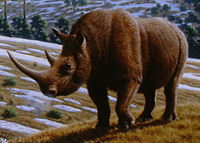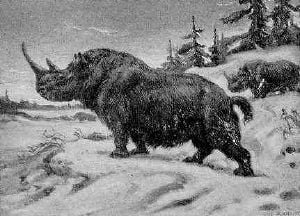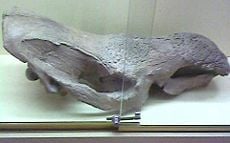Difference between revisions of "Woolly rhinoceros" - New World Encyclopedia
Rick Swarts (talk | contribs) |
Rick Swarts (talk | contribs) |
||
| Line 20: | Line 20: | ||
==Description== | ==Description== | ||
| − | As a member of the rhinoceros family, Rhinocerotidae, the woolly rhinoceros is an [[odd-toed ungulate]] | + | As a member of the rhinoceros family, Rhinocerotidae, the woolly rhinoceros is an [[odd-toed ungulate]] and is characterized by large size and projections or "horns" on the upper snout. It was native to the northern [[steppes]] of [[Eurasia]], living during the Pleistocene epoch and surviving through the [[last glacial period]]. The woolly rhinoceros are members of the [[Pleistocene megafauna]]. The genus name ''Coelodonta'' comes from the Greek for "hallow teeth" and the specific name ''antiquitatis'' comes from the Latin ''antiquus'' for "old" (IRF). |
[[Image:Wooly rhinoceros.jpg|thumb|left]] | [[Image:Wooly rhinoceros.jpg|thumb|left]] | ||
Revision as of 15:47, 29 June 2008
| Woolly Rhinoceros
| ||||||||||||||
|---|---|---|---|---|---|---|---|---|---|---|---|---|---|---|
 | ||||||||||||||
| Scientific classification | ||||||||||||||
| ||||||||||||||
| Coelodonta antiquitatis (Blumenbach, 1807) |
Woolly rhinoceros is the common name for an extinct, plant-eating species of rhinoceros, Coelodonta antiquitatis, that lived from about 350,000 years ago until about 10,000 years ago in Europe and Asia and was characterized by two "horns" (matted hair) on the upper snout and a thick and shaggy coat of hair. With fossils indicating a range throughout Northern Europe and Eastern Asia, from South Korea to Scotland to Spain, the woolly rhinoceros during the later part of the Pleistocene epoch may have had the most extensive range of any known living or extinct rhinoceros. The woolly rhinoceros appears in the cave paintings of early humans (Ballenger and Myers 2001), who may have hunted them.
Description
As a member of the rhinoceros family, Rhinocerotidae, the woolly rhinoceros is an odd-toed ungulate and is characterized by large size and projections or "horns" on the upper snout. It was native to the northern steppes of Eurasia, living during the Pleistocene epoch and surviving through the last glacial period. The woolly rhinoceros are members of the Pleistocene megafauna. The genus name Coelodonta comes from the Greek for "hallow teeth" and the specific name antiquitatis comes from the Latin antiquus for "old" (IRF).
Fossils indicate that the woolly rhinoceros was about 3.0 to 3.8 meters (10 to 12.5 feet) in length, with a height of 2 meters (6 feet) at the shoulder, and a weight of up to 3 tons (IRF). It had two horns on its snout, the anterior one larger than the one between its eyes and about 1 meter (3 feet) long. The front and larger horn also had a flattened shape from side to side (IRF). Both projections on the upper snout were not really true horns, but epidermal derivatives, composed of a solid mass of thickly matted hair—keratin, a hair protein—that grows from the skull without skeletal support.
It had thick, long fur, small ears, short, thick legs, and a stocky body. Cave paintings suggest a wide dark band between the front and hind legs, but it is not universal and identification of rhinoceros as woolly rhinoceros is uncertain. The woolly rhinoceros used its horns to sweep snow away from vegetation so it could eat in the winter.
As the last and most derived member of the Pleistocene rhinoceros lineage, the woolly rhinoceros was supremely well adapted to its environment. Stocky limbs and thick woolly pelage made it well suited to the steppe-tundra environment prevalent across the Palearctic ecozone during the Pleistocene glaciations. Its geographical range expanded and contracted with the alternating cold and warm cycles, forcing populations to migrate or perish as the glaciers receded. Like the vast majority of rhinoceroses both living and extinct, the body plan of the woolly rhinoceros adhered to the conservative morphology displayed in the most primitive rhinoceroses, first seen in the late Eocene. A close relative, the Giant Unicorn (Elasmotherium), had a more southern range.
Diet
Controversy has long surrounded the precise dietary preference of Coelodonta as past investigations have found both grazing and browsing modes of life to be plausible. The palaeodiet of the woolly rhinoceros has been reconstructed using several lines of evidence. Climatic reconstructions indicate the preferred environment to have been cold and arid steppe-tundra, with large herbivores forming an important part of the feedback cycle. Pollen analysis shows a prevalence of grasses and sedges within a more complicated vegetation mosaic.[citation needed]
A strain vector biomechanical investigation of the skull, mandible and teeth of a well-preserved last cold stage individual recovered from Whitemoor Haye, Staffordshire, revealed musculature and dental characteristics that support a grazing feeding preference. In particular, the enlargement of the temporalis and neck muscles is consistent with that required to resist the large tugging forces generated when taking large mouthfuls of fodder from the ground. The presence of a large diastema supports this theory.
Comparisons with extant perissodactyls confirm that Coelodonta was a hindgut fermentor with a single stomach, and as such would have grazed upon cellulose-rich, protein-poor fodder. This method of digestion would have required a large throughput of food and thus links the large mouthful size to the low nutritive content of the chosen grasses and sedges.[1]
Extinction
It was hunted by early humans, who may have contributed to its extinction. Its shape was known only from prehistoric cave drawings until a completely preserved specimen (missing only the fur and hooves) was discovered in a tar pit in Starunia, Poland. The specimen, an adult female, is now on display in the Polish Academy of Sciences' Museum of Natural History in Kraków. The woolly rhinoceros roamed much of Northern Europe and was common in the then cold, arid desert that is southern England and the North Sea today. During Greenland Stadial 2 (The Last Glacial Maximum) the North Sea did not exist as sea levels were up to 125 meters lower than today.
The woolly rhinoceros co-existed with woolly mammoths and several other extinct larger mammals. No specimens have been dated in the U.K. after 15,000 14C years B.P. [citation needed]
Recent radiocarbon dating has shown that populations survived as recently as 8,000 B.C.E. in Western Siberia.
- 8,000 B.C.E. is equivalent to 10,000 - 11,000 years B.P. (Before Present), and the accuracy of this date is uncertain as several radiocarbon plateaus exist around this time. The extinction does not coincide with the end of the last ice age but does coincide however, with a minor yet severe climatic reversal that lasted for about 1,000–1,250 years, the Younger Dryas (GS1 - Greenland Stadial 1), characterized by glacial readvances and severe cooling globally, a brief interlude in the continuing warming subsequent to the termination of the last major ice age (GS2), thought to have been due to a shutdown of the thermohaline circulation in the ocean due to huge influxes of cold, fresh water from the preceding sustained glacial melting during the warmer Interstadial (GI1 - Greenland Interstadial 1 - ca. 16,000 - 11,450 14c years B.P.).
A close relative, the Sumatran Rhinoceros (Dicerorhinus sumatrensis), still survives in Southeast Asia, but is highly endangered.
ReferencesISBN links support NWE through referral fees
- ↑ SAS Bulletin, Volume 26, number 3/4, Winter 2003 from the Society for Archaeological Sciences
Ballenger, L. and P. Myers. 2001. "Rhinocerotidae" (On-line), Animal Diversity Web. Accessed June 29, 2008 at http://animaldiversity.ummz.umich.edu/site/accounts/information/Rhinocerotidae.html.
- International Rhino Foundation (IRF). n.d. [http://www.rhinos-irf.org/woolly/ Woolly rhino (Coelodonta antiquitatis). International Rhino Foundation. Retrieved June 30, 2008.
Authors: Orlova, Lyobov A.; Kuzmin, Yaroslav V.; Dementiev, Vyacheslav N.
Source: Radiocarbon, Volume 46, Issue 1, Pages xiii-496 (January 2004) , pp. 301-314(14) A review of the radiocarbon chronology of some late Upper Pleistocene mammals from Siberia is presented. Previously published data has been supplemented by new 14C dates for 5 species (woolly mammoth, woolly rhinoceros, bison, horse, and muskox) to reconstruct chronological extinction patterns. The final extinction of woolly rhinoceros and bison in Siberia can be dated to approximately 11,000–9700 BP, but
External links
Credits
New World Encyclopedia writers and editors rewrote and completed the Wikipedia article in accordance with New World Encyclopedia standards. This article abides by terms of the Creative Commons CC-by-sa 3.0 License (CC-by-sa), which may be used and disseminated with proper attribution. Credit is due under the terms of this license that can reference both the New World Encyclopedia contributors and the selfless volunteer contributors of the Wikimedia Foundation. To cite this article click here for a list of acceptable citing formats.The history of earlier contributions by wikipedians is accessible to researchers here:
The history of this article since it was imported to New World Encyclopedia:
Note: Some restrictions may apply to use of individual images which are separately licensed.



